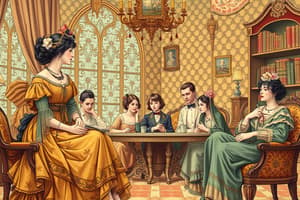Podcast
Questions and Answers
What period is referred to as the Age of Growing Inequality?
What period is referred to as the Age of Growing Inequality?
- End of World War II to early 1970's
- Mid-1970's onward (correct)
- 1980 to 1990
- 1910 to 1940
What defines the Age of Shared Prosperity?
What defines the Age of Shared Prosperity?
The years from the end of World War II to the early 1970's when incomes at all levels grew and inequalities were declining.
What does 'association' refer to in social terms?
What does 'association' refer to in social terms?
Patterns of interpersonal contact, such as leisure activities, friendship, and marriage among members of the same class.
What is the bourgeoisie?
What is the bourgeoisie?
What is capital defined as?
What is capital defined as?
How is capitalism defined?
How is capitalism defined?
Who is part of the capitalist class according to the Gilbert-Kahl model?
Who is part of the capitalist class according to the Gilbert-Kahl model?
What is class consciousness?
What is class consciousness?
What constitutes a family in studies of income?
What constitutes a family in studies of income?
What is the Gilbert-Kahl model of the class structure?
What is the Gilbert-Kahl model of the class structure?
What is a household?
What is a household?
How does Marx define ideology?
How does Marx define ideology?
What are life chances?
What are life chances?
What does lifestyle refer to according to Weber?
What does lifestyle refer to according to Weber?
What are means of production in Marxist terms?
What are means of production in Marxist terms?
Study Notes
Age of Growing Inequality
- Began in the mid-1970s, marked by rising inequality in wages, income, and wealth.
- Contrasts with the earlier Age of Shared Prosperity, where economic equality was more prevalent.
Age of Shared Prosperity
- Spanned from the end of World War II to the early 1970s.
- Characterized by robust income growth across all levels and decreasing economic and social inequalities.
Association
- Refers to patterns of social interaction, including leisure activities and friendships, primarily among individuals of the same class.
- Results in the formation of class subcultures with shared values and lifestyles.
Bourgeoisie
- Term used by Marx for the class owning the means of production and controlling society's superstructure within a capitalist framework.
Capital
- Encompasses funds, goods, land, and machinery invested in a business.
- Bourdieu identifies three forms of capital:
- Economic Capital: monetary assets and property rights.
- Cultural Capital: knowledge and educational credentials, including social manners and skills.
- Social Capital: networks of mutual obligations like kinship and friendship.
Capitalism
- An economic system characterized by private business ownership and market-based trade of capital, labor, goods, and services.
Capitalist Class
- In the Gilbert-Kahl model, represents a small elite whose income primarily comes from returns on capital assets, equated with Marx's bourgeoisie.
Class Consciousness
- Awareness among class members of their shared identity and interests, viewed by Marx as a precursor to class conflict.
- Modern analysis focuses on its influence on political opinions and labor advocacy.
Family
- Defined as two or more related individuals living together, representing the most common household type in income studies.
Gilbert-Kahl Model of the Class Structure
- A framework categorizing the American class system based on economic factors and sources of income, consisting of six classes: capitalist class, upper-middle class, middle class, working class, working poor, and underclass.
Household
- Refers to a domestic unit, including families, individuals living alone, and unrelated persons cohabiting.
Ideology
- Concept by Marx denoting the dominant ideas justifying societal structures and the ruling class's privileges.
- Embedded in various societal institutions such as religion, family, and education.
Life Chances
- Concept introduced by Max Weber, emphasizing how class membership influences future opportunities, from nutrition in infancy to adult career success.
Lifestyle
- Defined by Weber as unique social interaction patterns and consumption behaviors associated with a social group or status group.
Means of Production
- In Marx's theory, represents the physical means necessary for production, including land, machinery, and factories.
Studying That Suits You
Use AI to generate personalized quizzes and flashcards to suit your learning preferences.
Description
Explore key definitions from Chapter 1 of 'The American Class Structure in an Age of Growing Inequality.' This flashcard quiz focuses on important terms and concepts that characterize the evolving landscape of social and economic inequality from the mid-1970s onward.




